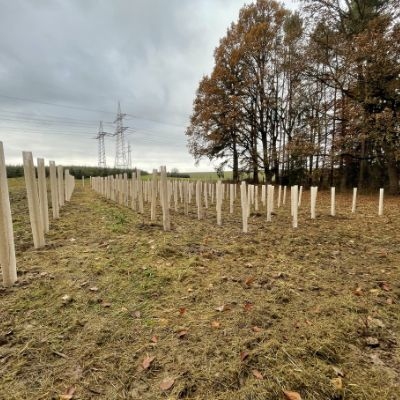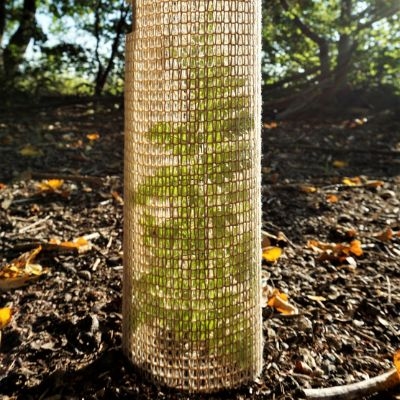Forest-friendly: The bio-based and biodegradable tree growth sleeve.
A matter of the heart: the Buckshülle made of circular knitted fabric.
We all know them from our Sunday walk in the woods: the conventional tree growth covers made of plastic. They fulfill their purpose of protecting the young trees. But after their mission is accomplished, they usually remain in the forest. As the plastic gradually decomposes, it pollutes the forest floor with microplastics. Alfred E. Buck read about this problem in the newspaper. And he asked himself how he could contribute to solving this problem with his team and unique know-how.
The mission: a forest without microplastics.
Foresters, communities, tree nurseries, private forest owners, forestry companies, and forest owners' associations: they should all feel better with an environmentally friendly, biodegradable tree cover. After all, who would want to leave a forest contaminated with plastic to future generations? But above all, the forest itself would benefit.
Versuche, eine biologisch abbaubare Wuchshülle zu etablieren, hatte es schon einige gegeben. Vor allem Wuchshüllen aus Karton, Papier oder Holz. Ihr Nachteil: Sie halten entweder nicht die mindestens nötigen sechs Jahre – oder sie sind zu schwer und zu kompliziert aufzubauen. Damit war die Aufgabe für das BUCK Team klar: eine Wuchshülle, die beim Zersetzungsprozess kein Mikroplastik im Wald hinterlässt, die leicht, dazu einfach in der Handhabung ist und die junge Bäumchen ausreichend vor Tieren schützt.
There had already been a few attempts to establish a biodegradable growing medium. Above all, growing bags made of cardboard, paper or wood. Their disadvantage: they either do not last the minimum six years required - or they are too heavy and too complicated to set up. So the task for the BUCK team was clear: a growth cover that does not leave any microplastics in the forest during the decomposition process, that is light, easy to handle and that protects young trees sufficiently from animals.
Final solution after a year and a half of development.
One and a half years of research and testing passed until the final solution was found. Not without setbacks and constant optimization: Producing a cover with sufficient stability was one of the major challenges, requiring several approaches. To develop the yarn, we commissioned the DITF Denkendorf (German Institutes for Textile and Fiber Research) to develop a fiber or yarn that was both biodegradable and knittable. Flax was first considered as a natural fiber, but it was later replaced by cotton - simply because it is available in larger quantities. Polylactides (PLA), obtained from renewable resources such as corn, was to provide the necessary stiffness. To produce the final product, PLA and cotton fiber were "intimately spun" and knitted. At the end of the production process, an air- and light-permeable tube is created from the circular knit.
When a suitable yarn manufacturer was finally found, series production could begin. But this turned out to be much more complicated than expected. Difficulties arose during production that had yet to be anticipated. But in the end, these too were overcome.
Bio-based, lightweight, and easy to handle.
The result is a biobased and biodegradable knitted tree cover that is pleasingly light at 150 grams and easy to handle simultaneously. It's not just the environment that's happy about it; the feedback has been consistently positive in other respects, too. And the demand is immense: In the meantime, tree nurseries, Forst BW, forest owners' associations, municipalities and private forest owners are already successfully using the product. And, of course, the entire BUCK team is just as pleased as initiator Alfred E. Buck to be able to contribute to protecting the forest from microplastics with a technical mesh.


